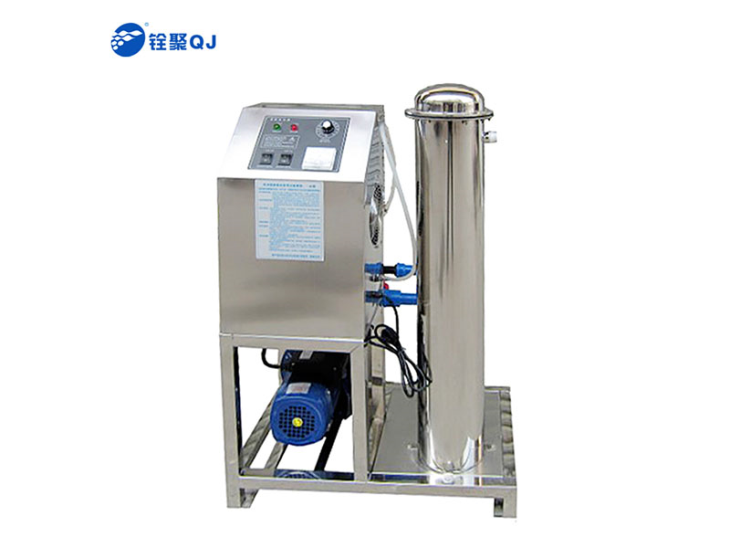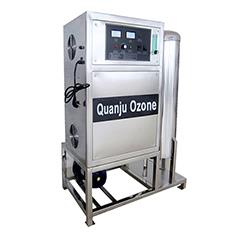
Fruit and vegetable disinfection high concentration ozone water machine
Principle of Disinfection The principle of ozone disinfection is that ozone produces a redox reaction in the water. It produces monoatomic oxygen (O) and hydroxyl (OH), which are extremely strong in oxidation, and instantly differentiates organic substances, bacteria and microorganisms in the water.
Disinfection principle of high concentration ozone water machine for fruit and vegetable disinfection
Chlorine disinfection contains liquid chlorine, bleaching powder, sodium hypochlorite, and chloramine. The principle of disinfection is that chlorine will have the following reaction in water: Cl2 {{2}} H2O → HCl + HOCl → 2H+ + Cl- + OCl-
The hypochlorous acid generated by the reaction has a strong penetrating power, and can quickly pass through the cell membrane of the microorganisms and enter the microorganisms, damaging the system in the microorganisms and losing vitality and causing death. On the other hand, hypochlorous acid is very unstable in nature, that is, it is easy to release new ecological oxygen [O]. The new ecological oxygen is combined with ammonium salt, hydrogen sulfide, ferrous oxide, nitrite, and substances that occur after organic matter corruption. Organic matter and some inorganic matter in the water oxidize, and then inhibit the growth of most microorganisms that rely on these substances as nutrients. Therefore, hypochlorous acid is generally considered to have the primary sterilization effect. However, the hypochlorous acid radical generated in the response has weak sterilizing power and does not have the ability of hypochlorous acid to penetrate the cell membrane of microorganisms, so its disinfection effect is much lower than that of hypochlorous acid.
The principle of ultraviolet disinfection is that the spectral wavelength of ultraviolet light has the ability to sterilize in the range of 490nm -140nm. After microorganisms are irradiated by ultraviolet rays, the nuclear proteins in the gas will be denatured by absorbing the energy of the ultraviolet spectrum, causing metabolic hindrance and loss of reproduction ability. When the irradiation dose is increased by a certain amount, the microbial cells are damaged and killed. Ultraviolet rays have certain penetrating power to clear and transparent water, so it can disinfect water.
The principle of ozone disinfection is that ozone produces a redox reaction in the water, which produces monoatomic oxygen (O) and hydroxyl (OH), which can be extremely oxidized, and instantly differentiates organic substances, bacteria and microorganisms in the water. Hydroxyl (OH) is a strong oxidant and catalyst, which can make organic matter have a chain reaction, and the reaction is very quick. Hydroxyl (OH) has a strong killing effect on various pathogenic microorganisms. Monoatomic oxygen (O) also has strong oxidizing ability and has strong lethality to strong microorganisms such as viruses and spores.
Drinking water such as tap water is now widely used for disinfection in our country. The use of chlorine method has serious secondary pollution problems. Since 1973, the Netherlands, Canada, the United States and other countries have successively discovered that halogenated organic compounds (chloroform, chloramine, etc.) can occur in tap water disinfected with chlorine, which has been proved to be carcinogenic by animal experiments. Moreover, chlorine disinfection is easily affected by temperature and pH. Residual chlorine can also affect the taste of drinking water, especially for beverage water. Residual chlorine will cause the smell of chlorine in carbonated beverages and other beverage products, and oxidize the pigment in the beverage, which affects product quality.
When UV disinfection is used, the irradiating energy required for the death of different bacteria is quite different. On the other hand, the raw water quality also has an impact on the UV sterilization effect. Due to the limited penetration of UV rays in the water, it is difficult to achieve the ideal effect. And UV disinfection cannot maintain the disinfection effect like residual chlorine.
Ozone has a stronger ability to oxidize and disinfect than chlorine. It can not only sterilize and disinfect more thoroughly, but also degrade harmful components in water and remove heavy metal ions and various organic impurities such as iron, manganese, sulfide, benzene, phenol , Organic phosphorus, organic chlorine, cyanide, etc., can also deodorize and decolor the water, and then achieve the purpose of purifying water. Ozone has a strong habit, and is less affected by water temperature and PH value. Ozone has a wide range of habits and is not restricted by bacteria, and its sterilization effect is better than chlorine and ultraviolet sterilization. Unlike chlorine, residual ozone can differentiate into oxygen on its own without secondary pollution. The ozone-treated water is colorless, odorless, has a good taste, and can improve the quality of drinking water.
Therefore, in order to improve the quality of bottled drinking water and extend the shelf life, the World Bottled Water Association (IBWA) recommends ozone treatment. Before ozone treatment, bottled water generally uses reverse osmosis, nanofiltration, and ultrafiltration to remove 99% of the organic matter in natural water and reduce the amount of ozone.

Send Inquiry

